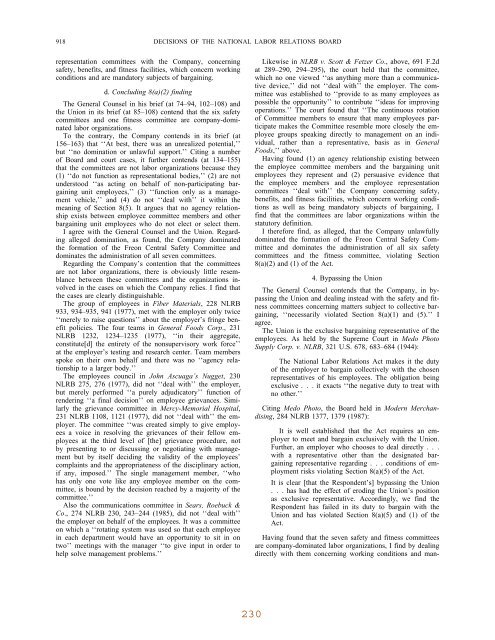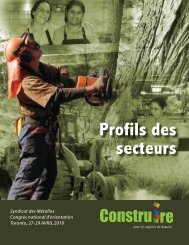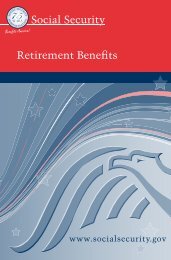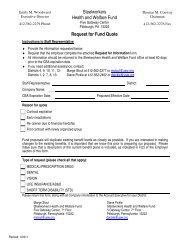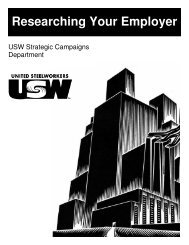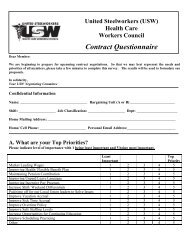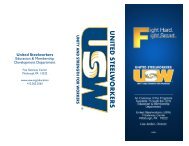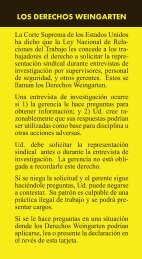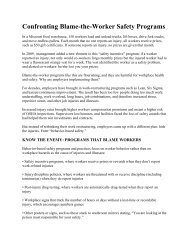Union Approach to Health and Safety: - United Steelworkers
Union Approach to Health and Safety: - United Steelworkers
Union Approach to Health and Safety: - United Steelworkers
Create successful ePaper yourself
Turn your PDF publications into a flip-book with our unique Google optimized e-Paper software.
918 DECISIONS OF THE NATIONAL LABOR RELATIONS BOARD<br />
representation committees with the Company, concerning<br />
safety, benefits, <strong>and</strong> fitness facilities, which concern working<br />
conditions <strong>and</strong> are m<strong>and</strong>a<strong>to</strong>ry subjects of bargaining.<br />
d. Concluding 8(a)(2) finding<br />
The General Counsel in his brief (at 74–94, 102–108) <strong>and</strong><br />
the <strong>Union</strong> in its brief (at 85–108) contend that the six safety<br />
committees <strong>and</strong> one fitness committee are company-dominated<br />
labor organizations.<br />
To the contrary, the Company contends in its brief (at<br />
156–163) that ‘‘At best, there was an unrealized potential,’’<br />
but ‘‘no domination or unlawful support.’’ Citing a number<br />
of Board <strong>and</strong> court cases, it further contends (at 134–155)<br />
that the committees are not labor organizations because they<br />
(1) ‘‘do not function as representational bodies,’’ (2) are not<br />
unders<strong>to</strong>od ‘‘as acting on behalf of non-participating bargaining<br />
unit employees,’’ (3) ‘‘function only as a management<br />
vehicle,’’ <strong>and</strong> (4) do not ‘‘deal with’’ it within the<br />
meaning of Section 8(5). It argues that no agency relationship<br />
exists between employee committee members <strong>and</strong> other<br />
bargaining unit employees who do not elect or select them.<br />
I agree with the General Counsel <strong>and</strong> the <strong>Union</strong>. Regarding<br />
alleged domination, as found, the Company dominated<br />
the formation of the Freon Central <strong>Safety</strong> Committee <strong>and</strong><br />
dominates the administration of all seven committees.<br />
Regarding the Company’s contention that the committees<br />
are not labor organizations, there is obviously little resemblance<br />
between these committees <strong>and</strong> the organizations involved<br />
in the cases on which the Company relies. I find that<br />
the cases are clearly distinguishable.<br />
The group of employees in Fiber Materials, 228 NLRB<br />
933, 934–935, 941 (1977), met with the employer only twice<br />
‘‘merely <strong>to</strong> raise questions’’ about the employer’s fringe benefit<br />
policies. The four teams in General Foods Corp., 231<br />
NLRB 1232, 1234–1235 (1977), ‘‘in their aggregate,<br />
constitute[d] the entirety of the nonsupervisory work force’’<br />
at the employer’s testing <strong>and</strong> research center. Team members<br />
spoke on their own behalf <strong>and</strong> there was no ‘‘agency relationship<br />
<strong>to</strong> a larger body.’’<br />
The employees council in John Ascuaga’s Nugget, 230<br />
NLRB 275, 276 (1977), did not ‘‘deal with’’ the employer,<br />
but merely performed ‘‘a purely adjudica<strong>to</strong>ry’’ function of<br />
rendering ‘‘a final decision’’ on employee grievances. Similarly<br />
the grievance committee in Mercy-Memorial Hospital,<br />
231 NLRB 1108, 1121 (1977), did not ‘‘deal with’’ the employer.<br />
The committee ‘‘was created simply <strong>to</strong> give employees<br />
a voice in resolving the grievances of their fellow employees<br />
at the third level of [the] grievance procedure, not<br />
by presenting <strong>to</strong> or discussing or negotiating with management<br />
but by itself deciding the validity of the employees’<br />
complaints <strong>and</strong> the appropriateness of the disciplinary action,<br />
if any, imposed.’’ The single management member, ‘‘who<br />
has only one vote like any employee member on the committee,<br />
is bound by the decision reached by a majority of the<br />
committee.’’<br />
Also the communications committee in Sears, Roebuck &<br />
Co., 274 NLRB 230, 243–244 (1985), did not ‘‘deal with’’<br />
the employer on behalf of the employees. It was a committee<br />
on which a ‘‘rotating system was used so that each employee<br />
in each department would have an opportunity <strong>to</strong> sit in on<br />
two’’ meetings with the manager ‘‘<strong>to</strong> give input in order <strong>to</strong><br />
help solve management problems.’’<br />
Likewise in NLRB v. Scott & Fetzer Co., above, 691 F.2d<br />
at 289–290, 294–295), the court held that the committee,<br />
which no one viewed ‘‘as anything more than a communicative<br />
device,’’ did not ‘‘deal with’’ the employer. The committee<br />
was established <strong>to</strong> ‘‘provide <strong>to</strong> as many employees as<br />
possible the opportunity’’ <strong>to</strong> contribute ‘‘ideas for improving<br />
operations.’’ The court found that ‘‘The continuous rotation<br />
of Committee members <strong>to</strong> ensure that many employees participate<br />
makes the Committee resemble more closely the employee<br />
groups speaking directly <strong>to</strong> management on an individual,<br />
rather than a representative, basis as in General<br />
Foods,’’ above.<br />
Having found (1) an agency relationship existing between<br />
the employee committee members <strong>and</strong> the bargaining unit<br />
employees they represent <strong>and</strong> (2) persuasive evidence that<br />
the employee members <strong>and</strong> the employee representation<br />
committees ‘‘deal with’’ the Company concerning safety,<br />
benefits, <strong>and</strong> fitness facilities, which concern working conditions<br />
as well as being m<strong>and</strong>a<strong>to</strong>ry subjects of bargaining, I<br />
find that the committees are labor organizations within the<br />
statu<strong>to</strong>ry definition.<br />
I therefore find, as alleged, that the Company unlawfully<br />
dominated the formation of the Freon Central <strong>Safety</strong> Committee<br />
<strong>and</strong> dominates the administration of all six safety<br />
committees <strong>and</strong> the fitness committee, violating Section<br />
8(a)(2) <strong>and</strong> (1) of the Act.<br />
4. Bypassing the <strong>Union</strong><br />
The General Counsel contends that the Company, in bypassing<br />
the <strong>Union</strong> <strong>and</strong> dealing instead with the safety <strong>and</strong> fitness<br />
committees concerning matters subject <strong>to</strong> collective bargaining,<br />
‘‘necessarily violated Section 8(a)(1) <strong>and</strong> (5).’’ I<br />
agree.<br />
The <strong>Union</strong> is the exclusive bargaining representative of the<br />
employees. As held by the Supreme Court in Medo Pho<strong>to</strong><br />
Supply Corp. v. NLRB, 321 U.S. 678, 683–684 (1944):<br />
The National Labor Relations Act makes it the duty<br />
of the employer <strong>to</strong> bargain collectively with the chosen<br />
representatives of his employees. The obligation being<br />
exclusive . . . it exacts ‘‘the negative duty <strong>to</strong> treat with<br />
no other.’’<br />
Citing Medo Pho<strong>to</strong>, the Board held in Modern Merch<strong>and</strong>ising,<br />
284 NLRB 1377, 1379 (1987):<br />
It is well established that the Act requires an employer<br />
<strong>to</strong> meet <strong>and</strong> bargain exclusively with the <strong>Union</strong>.<br />
Further, an employer who chooses <strong>to</strong> deal directly . . .<br />
with a representative other than the designated bargaining<br />
representative regarding . . . conditions of employment<br />
risks violating Section 8(a)(5) of the Act.<br />
It is clear [that the Respondent’s] bypassing the <strong>Union</strong><br />
. . . has had the effect of eroding the <strong>Union</strong>’s position<br />
as exclusive representative. Accordingly, we find the<br />
Respondent has failed in its duty <strong>to</strong> bargain with the<br />
<strong>Union</strong> <strong>and</strong> has violated Section 8(a)(5) <strong>and</strong> (1) of the<br />
Act.<br />
Having found that the seven safety <strong>and</strong> fitness committees<br />
are company-dominated labor organizations, I find by dealing<br />
directly with them concerning working conditions <strong>and</strong> man-


